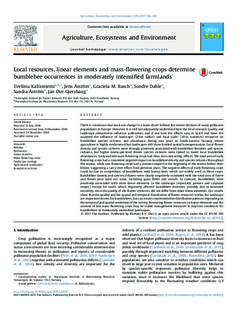Local resources, linear elements and mass-flowering crops determine bumblebee occurrences in moderately intensified farmlands
Kallioniemi, Eveliina; Åström, Jens; Rusch, Graciela; Dahle, Sondre; Åström, Sandra Charlotte Helene; Gjershaug, Jan Ove
Journal article, Peer reviewed

Åpne
Permanent lenke
http://hdl.handle.net/11250/2443144Utgivelsesdato
2017Metadata
Vis full innførselSamlinger
- Publikasjoner fra CRIStin - NINA [2364]
- Scientific publications [1392]
Sammendrag
There is consensus that land-use change is a main driver behind the recent declines of many pollinator
populations in Europe. However, it is still not adequately understood how the local resource quality and
landscape composition influence pollinators, and if and how the effects vary in space and time. We
analysed the influence of landscape- (2 km radius) and local scale- (50 m transects) resources on
bumblebee species richness and abundance during two years in South-eastern Norway, where
agriculture is highly modernised but landscapes still show limited spatial homogenization. Local
flower
density and species richness were strongly positively associated with bumblebee densities and species
richness, but higher landscape-level
flower species richness were linked to lower local bumblebee
abundances. Early and late mass
flowering crops had clear, but contrasting, effects. The total area of early
flowering crops had a consistent negative impact on bumblebee density and species richness throughout
the season, while late
flowering crops had a positive impact in the beginning of the season before their
bloom, suggesting a carry-over effect from previous years. The negative effects of early
flowering crops
could be due to competition of bumblebees with honey-bees, which are widely used in these crops.
Bumblebee density and species richness were clearly negatively correlated with the total area of forest
and
flower-poor land use areas, including grass
fields and cereals. In contrast, bumblebees were
positively associated with most linear elements in the landscape (especially pasture and cropland
verges), except for roads, which negatively affected bumblebee densities, possibly due to increased
mortality, since the quality of the
flower resources did not differ from other linear elements. Our results
show that the quality and the spatial and temporal distribution of
flower resources within the landscape
are important drivers for bumblebees, but can create counterintuitive distribution patterns depending on
the temporal and spatial resolution of the survey. Increasing
flower resources in linear elements and the
amount of late mass-flowering crops may be viable management measures to improve conditions for
bumblebees in moderately intensified landscapes.
© 2017 The Authors. Published by Elsevier B.V. This is an open access article under the CC BY-NC-ND
license (http://creativecommons.org/licenses/by-nc-nd/4.0/).
